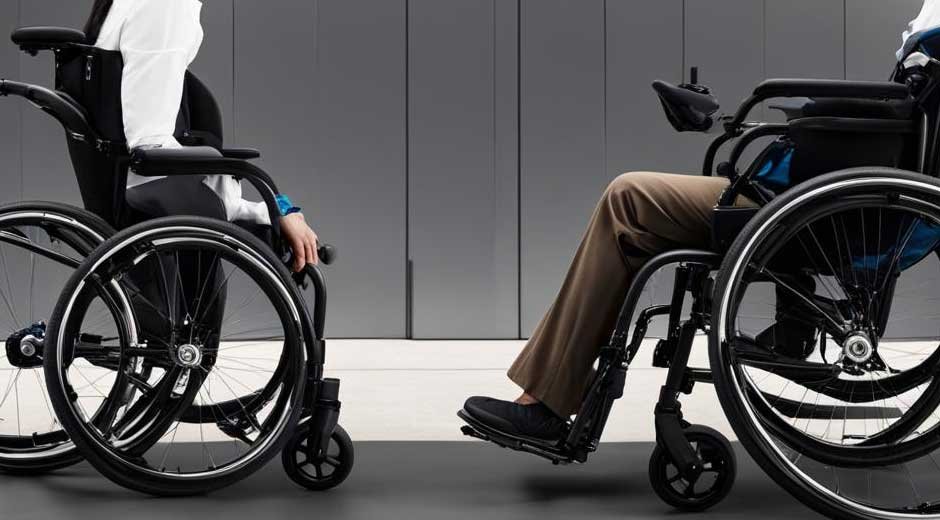Skip to the good bit
ToggleChoosing the right wheelchair can be a daunting task for individuals with mobility impairments. With numerous options available, it is essential to consider specific needs and lifestyle when making a decision. This article delves into key factors to consider when choosing a wheelchair and provides guidance on mastering wheelchair techniques, modifying living spaces, maintaining wheelchairs, and staying active and healthy.
Choosing the Right Wheelchair
When selecting a wheelchair, consider your mobility goals and how you plan to use the chair. Determine if you need a chair for everyday use or just for occasional outings. Consider whether you will be using the chair primarily indoors or outdoors. Next, consider the type of wheelchair that best suits your needs. Options include manual, power, and hybrid wheelchairs. Manual wheelchairs are ideal for maintaining physical strength and endurance, while power wheelchairs are better suited for those requiring more assistance with mobility.
It is also essential to consider the size and weight of the wheelchair, as well as its maneuverability and stability. A wheelchair that is too large or too heavy can be difficult to navigate, while a chair that is too small may not provide adequate support.
Mastering Wheelchair Techniques
Mastering wheelchair techniques takes time and practice but is crucial for maintaining independence and mobility. Start by practicing basic wheelchair skills, such as propelling, turning, and stopping. Learn to navigate different types of terrain, such as ramps, curbs, and uneven surfaces. In addition to basic wheelchair skills, learn to perform more advanced maneuvers, such as navigating tight spaces and using public transportation. Practice these skills in a safe and controlled environment, such as an empty parking lot.
Modifying Your Living Space
Modifying your living space can be essential for maintaining independence and mobility. Assess your home and identify any barriers or obstacles that may be preventing you from moving freely. Common modifications include installing ramps, widening doorways, and modifying bathroom and kitchen facilities. Ensure your home is well-lit and free from clutter, which can be a tripping hazard.
Maintaining Your Wheelchair
Regular maintenance is essential for keeping your wheelchair in good working order. Check your wheelchair regularly for signs of wear and tear, such as flat tires or loose screws. Follow a regular maintenance schedule, including tasks such as cleaning and lubricating moving parts, checking and replacing batteries, and performing routine safety checks.
The Importance of Exercise
Staying active and healthy is essential for maintaining independence and mobility. Regular exercise can improve strength and endurance, reduce the risk of chronic diseases, and enhance overall well-being. There are various types of exercise that can be adapted for individuals with mobility impairments, including wheelchair sports, adaptive yoga, and resistance band exercises. Consult with a healthcare professional before starting any new exercise program.
Planning Ahead for Outings
Planning ahead for outings can ensure a smooth and enjoyable experience. Research the accessibility of your destination, as well as any transportation or accommodations you may need. Plan for specific needs, such as accessible restrooms or seating areas. Prepare for unexpected challenges by packing a backup power source for your wheelchair, bringing a spare set of clothes, or having a plan in place for emergency situations.
Connecting with the Wheelchair Community
Connecting with others who share similar experiences can be a powerful way to build relationships and seek support. Join a local support group or organization to connect with others who understand what you’re going through. Attend conferences and workshops, read industry publications, and connect with other individuals and organizations passionate about adaptive technology.
Advocating for Accessibility
Advocating for accessibility is essential for ensuring that your rights are respected and protected. Understand your rights under the law, such as the Disability Discrimination Act 1992 in Australia. Develop effective advocacy skills, including learning to communicate with policymakers, business leaders, and other stakeholders. Develop strategies for building support and mobilizing action.
Embracing Adaptive Technologies
Adaptive technologies can enhance independence and quality of life. Explore innovative devices and tools, such as advanced wheelchairs and mobility scooters. Stay up-to-date with the latest advancements in adaptive technology by attending conferences and workshops, reading industry publications, and connecting with other individuals and organizations passionate about adaptive technology.
Prioritizing Self-Care
Prioritizing self-care is essential for managing physical and mental health. Listen to your body and pay attention to your physical needs, such as getting enough rest and engaging in regular exercise. Develop healthy coping mechanisms and strategies for managing stress and anxiety. This can include meditation, mindfulness, creative pursuits, and social connections.
Being Patient with Yourself
Adjusting to life as a wheelchair user can be a challenging and emotional journey. Be patient with yourself and allow yourself time and space to adjust. Remember that everyone’s journey is unique, and it’s essential to focus on your own progress and well-being. Seek support from friends, family, and healthcare professionals when needed.
Conclusion
Empowering independence as a new wheelchair user requires a comprehensive approach that addresses physical, emotional, and social needs. By choosing the right wheelchair, mastering wheelchair techniques, modifying living spaces, maintaining wheelchairs, and staying active and healthy, individuals with mobility impairments can maintain their independence and autonomy. Connecting with the wheelchair community, advocating for accessibility, embracing adaptive technologies, and prioritizing self-care are also essential components of empowering independence. By taking control of your independence and autonomy, and being patient with yourself as you adjust to your new circumstances, you can thrive as a new wheelchair user and live a fulfilling and meaningful life.







